Coincidence of Celebrations
 At the Haenam Bus Station waiting to go to Daeheunsa Temple.
At the Haenam Bus Station waiting to go to Daeheunsa Temple.That’s what this mystery person/traveler’s angels/another Korean (Korean American? maybe she’d identify that way, I would identify her that way) said to my friend and I at the Daheungsa Temple tea gift shop on Friday, Children’s Day/Buddha’s Birthday.
She noticed us because Becky and I had unknowingly, but very quietly and politely, crashed a gathering of “Who’s Who” of tea at the Il Chi Am monk hermitage near Daeheungsa. It just so happened, lucky for me and Becky, that not even half the same turnout appeared at Daeheungsa, which is probably how the woman was able to pick us out.
I call her one of those angels traveling brings your way because just as she said, there were just so many coincidences this festival weekend, and also because she just happened to have embodied, experienced, mentioned, or encouraged so many things Becky and I talked about that afternoon on our sweaty hike before we met her; thoughts that I had been brooding about lately: the Korean educational system, Korean history and resistance, my future plans which may possibly include dance therapy.
The woman spoke English and grabbed our attention, "You were at the hermitage, right?" She then dropped a bunch of knowledge on the importance of the temple we were at and its significance in the revival of tea and tea ceremony in Korea. Tea ceremony, which is a large part of Buddhism, was wiped out when Confucianism came during the Joseon dynasty. Since tea ceremony –a part of Buddhism—was also such a natural part of all daily rituals in the government and home, abolishing it was a way to ensure Buddhism would be wiped out as well.
She continued on about the rich history of our southern region of Korea, naming places in north Jeolla-do –Jinan and Mai Mountain—as places rich in beauty, legends, and Korean spirit. Just the stuff that I am always searching for and finding here in southern Korea. Most people from Seoul that I meet or talk to my friends, hate on this area –maybe much like how us Yankees in the north write-off the Deep South and all their red states. A lot of people from Seoul seem to hate the accent down here, call the people gangsters, and the only credit they give is the “supposedly good food.” There’s no supposing, the food is excellent, and though people are in some ways tough, they’re always friendly and chatty. As the woman explained, Jeolla-do was historically an agricultral heaven and an important governmental center, I am guessing in the Paekjae dynasty. But as what happens through war and petty politics, this region was left out of its share of resources and development once the Shilla dynasty took over. That extended into modern history as presidents came from the Eastern side of the country. It wasn't until Kim Dae Jung --native to Jeollanam-do and lovingly referred to as "DJ"-- became president. So, if you’re region of the country was neglected resources and development because of corrupt, petty politics, you’d probably be tough, too. I’m sure the history of resistance in this area doesn’t please many conservative folks up north, either. Gwangju City, one hour north of Mokpo, is where the Gwanju Uprising happened, when hundreds of student activists and citizens were massacred for their movement of democracy and conscience against the Park Chung Hee dictatorship in the early 80s.
Anyway, the woman, or Ms. Kim (I’d like to keep her as anonymous as possible) mentioned she had done demonstrations when she was young, studied public policy and danced in college (ha! like me!), taught multicultural education, and was now traveling doing photography and tea. It was vague, but the key is she liked connecting people.
It just confirmed for me that it doesn’t have to just be a dream that Kristofer and I pursue our loves for travel, coffee, and building coalitions between people. When I heard about the many places she had traveled to in search of real tea (artesian, hand-made, gourmet, not sure on the correct term), she had been to so many little-known places where many indigenous populations are forgotten by their governments and the larger country’s psyche. These are places Hilary has been going to, and that Kristofer and I seek out even in the more developed countries. It confirmed for me that I should go for dance therapy. Why not? Sustainable dance needs to remain in my life, and what better way for it to be than in this form, which physically, emotionally, and mentally connects with other people?
Oh…there’s so much to write. Because I realized Ms. Kim wasn’t an angel. She was just another person who had a rich history she knew and was pursuing what she loved, which is something I hope for all people to possess. So in conjunction with our traveling beans blog, Universal Truth #13: angels and miracles still come in the form of people and coincidences.
*I'd love to put the pictures into a much more aesthetically pleasing layout, but they took forever to upload and I am not going through that again. Hopefully they will be interesting anyway. Enjoy.
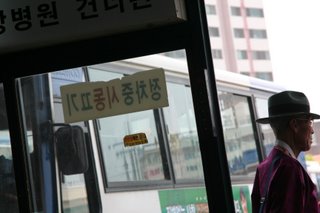
Dressed in Holiday best.
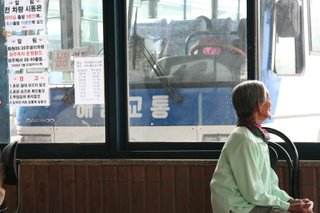
Waiting for the Daeheunsa bus.

Are we there yet?

A seat on the crowded bus.

Streetside snacks.

Who's on guard?

Always time for food.

Mountain water.

Family time.
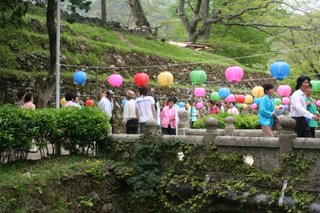
Lanterns and greenery.
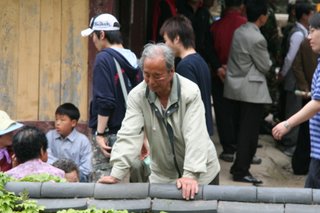
A moment.

At the Il Chi Am hermitage.
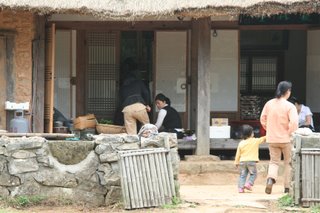
Preparing lunch.

Leftover tea ceremony.

Lanterns and woods.

Becky spotted something.

Water.

The baby's awake.

Shoes.

Back to lunch.

1 Comments:
Hi Jackie. I loved these pictures! Really. And I love to read about your travel adventures and get insight into korean culture (of which I am sadly lacking). Love, Your Cous. E
Post a Comment
<< Home